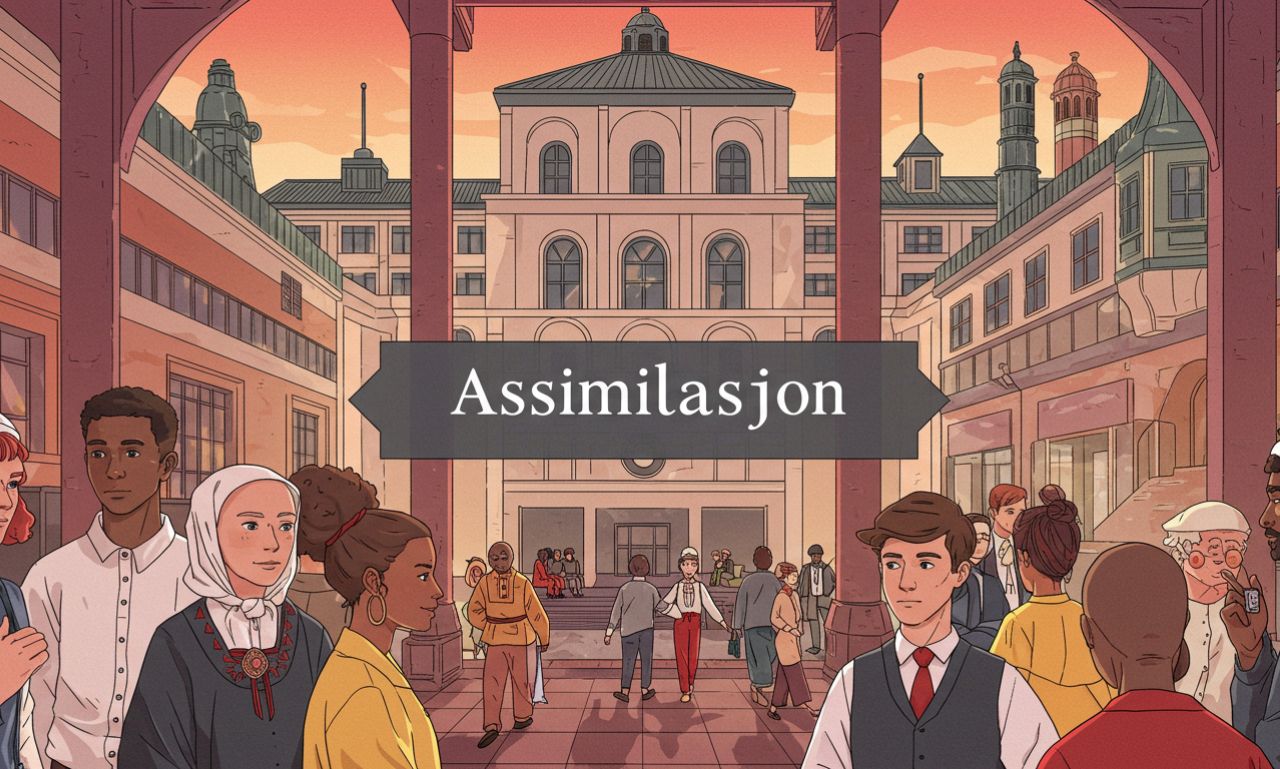The term assimilasjon, derived from the Latin assimilatio, refers to the process of becoming similar or integrating into another culture, language, or social group. In English, it translates to assimilation — a concept central to sociology, anthropology, and linguistics.
Over centuries, assimilas jon has played a key role in shaping societies, influencing identity formation, migration patterns, and cultural exchange. In modern times, it remains a topic of discussion as globalization, diversity, and social inclusion continue to evolve.
This article explores the meaning, history, and implications of assimilas jon, examining how it functions across different contexts — cultural, linguistic, and psychological.
The Meaning and Etymology of Assimilasjon
The word assimilas jon comes from the Latin ad (to) and similis (similar), meaning “to make similar.” It describes the process by which an individual or group gradually adopts the customs, values, and norms of another culture or community.
In simple terms, assimilas jon is about blending in — becoming part of a larger social fabric by adopting its language, traditions, and behaviors.
However, the depth of assimilas jon extends beyond imitation. It involves transformation — a dynamic interaction between personal identity and societal influence.
Historical Background of Assimilasjon
Throughout history, assimilasjon has been both a natural and enforced process. Ancient empires like Rome and Persia practiced cultural assimilation by encouraging or imposing their languages and customs on conquered peoples.
During colonial periods, assimilation was used as a tool of dominance — indigenous communities were often pressured to abandon their heritage in favor of colonial culture.
In modern societies, assimilas jon has taken a more voluntary form, occurring through migration, education, and cultural exchange. Yet, debates continue about whether assimilation should be encouraged, resisted, or balanced with multiculturalism.
Cultural Assimilasjon: A Two-Way Process
1. Definition of Cultural Assimilasjon
Cultural assimilasjon refers to the process by which individuals adopt the cultural traits of another group, often the dominant one. It includes language, dress, cuisine, and social behaviors.
For example, immigrants may gradually adopt the customs of their new country — celebrating local holidays, speaking the national language, or engaging in community activities.
2. Mutual Exchange in Assimilasjon
While assimilation is often viewed as one-sided, modern interpretations emphasize mutual adaptation. Host societies also evolve as they absorb new cultural influences, leading to hybrid identities and multicultural harmony.
Thus, assimilas jon can be seen not as the loss of culture, but as the creation of new cultural forms through interaction.
Linguistic Assimilasjon: The Role of Language
Language is a core element of assimilas jon. The way people speak reflects their belonging and identity.
1. Adapting to a New Language
When individuals move to a new country, learning the local language becomes essential for integration. This linguistic assimilas jon allows for better communication, employment opportunities, and social acceptance.
However, it can also create tension — as individuals balance between maintaining their native language and embracing a new one.
2. Linguistic Assimilasjon in History
Many languages have evolved through assimilation. For instance, English adopted countless words from Latin, French, and Norse due to historical conquests and cultural contact.
Similarly, modern globalization has led to English words entering other languages, showing that assimilasjon continues to shape linguistic landscapes worldwide.
Psychological Aspects of Assimilasjon
Assimilation is not only social or cultural — it’s also deeply psychological. It involves identity negotiation, belonging, and adaptation.
1. Identity Transformation
Individuals undergoing assimilas jon often experience identity shifts. They may feel caught between two worlds — the culture they come from and the one they are integrating into.
This dual identity can be enriching, but it may also cause internal conflict or a sense of displacement.
2. Emotional Adaptation
Emotional adaptation is a key component of successful assimilas jon. Acceptance, open-mindedness, and resilience help individuals feel comfortable in new cultural settings.
Counselors and psychologists often highlight cultural empathy and social support as essential factors in easing the assimilation process.
Social and Political Dimensions of Assimilasjon
1. Assimilasjon in Immigration Policies
In many countries, assimila sjon is a key theme in immigration policies. Governments encourage integration programs that help newcomers learn the national language, understand laws, and adapt to cultural norms.
For instance, Scandinavian countries often use the word assimilas jon in policy discussions related to social inclusion and national identity.
2. Assimilasjon vs. Multiculturalism
A major debate revolves around whether societies should prioritize assimilas jon or multiculturalism.
-
Assimilas jon emphasizes unity and shared identity.
-
Multiculturalism values diversity and coexistence.
Modern democratic societies often aim for a balance — encouraging integration without forcing conformity, celebrating differences while fostering a sense of belonging.
Assimilasjon in Education
Education plays a central role in the process of assimilasjon. Schools are spaces where cultural exchange happens naturally.
1. Cultural Learning and Integration
Students from diverse backgrounds learn local history, language, and values, which helps them integrate into the wider society.
Teachers play an essential role by promoting inclusive education — one that respects both local traditions and cultural diversity.
2. The Role of Bilingualism
Bilingual education is often seen as a bridge between assimilas jon and cultural preservation. It allows students to succeed academically while maintaining their linguistic heritage.
Challenges and Criticism of Assimilasjon
While assimilas jon can lead to unity and understanding, it also raises complex ethical and cultural issues.
1. Loss of Cultural Identity
Critics argue that assimilation can erase minority cultures, languages, and traditions. Forced assimilation — often practiced historically — led to the loss of indigenous heritage and cultural trauma.
Modern societies are now more aware of this, striving to promote inclusive assimilation, where individuals adapt without losing their roots.
2. Discrimination and Social Barriers
For assimilation to succeed, societies must be open and equitable. Discrimination, xenophobia, or social exclusion can make the process difficult, creating isolation rather than integration.
Hence, true assimilas jon requires empathy, equal opportunity, and mutual respect.
Assimilasjon in the Modern Global Context
Globalization, migration, and digital communication have transformed the meaning of assimilasj on.
Today, people live in multicultural environments where cultural exchange happens every day — through food, fashion, media, and technology.
Instead of one-way assimilation, we now experience intercultural blending, where traditions coexist and influence each other.
In this global era, assimilas jon is no longer about losing identity but about creating shared spaces that respect difference while fostering unity.
Examples of Assimilasjon in Practice
-
Immigrant Communities: Migrants who settle in new countries often adopt the host culture while maintaining their traditions — blending old and new identities.
-
Language Evolution: English incorporating global vocabulary is a classic case of linguistic assimilas jon.
-
Corporate Cultures: International companies practice organizational assimilas jon, where employees align with shared values and work ethics.
-
Digital Communities: Online platforms encourage global interaction, leading to virtual forms of assimilas jon where people adopt global digital norms.
The Positive Outcomes of Assimilasjon
When handled ethically and respectfully, assimilas jon can bring numerous benefits:
-
Promotes social unity and cooperation.
-
Enhances cross-cultural understanding.
-
Encourages economic participation and equal opportunity.
-
Fosters innovation through cultural exchange.
-
Strengthens communication across linguistic and ethnic boundaries.
These outcomes make assimilasj on an essential part of building peaceful, diverse, and prosperous societies.
Conclusion
Assimilasj on is more than just adaptation; it’s the continuous interaction between cultures, ideas, and identities. It reflects humanity’s ability to learn, adjust, and coexist.
While historical forms of assimilation were often rigid or oppressive, modern is about balance — finding harmony between preserving one’s roots and embracing new experiences.
In the end, the true success of assimilas jon lies in mutual respect, empathy, and shared growth — where diversity becomes a strength, not a division.

